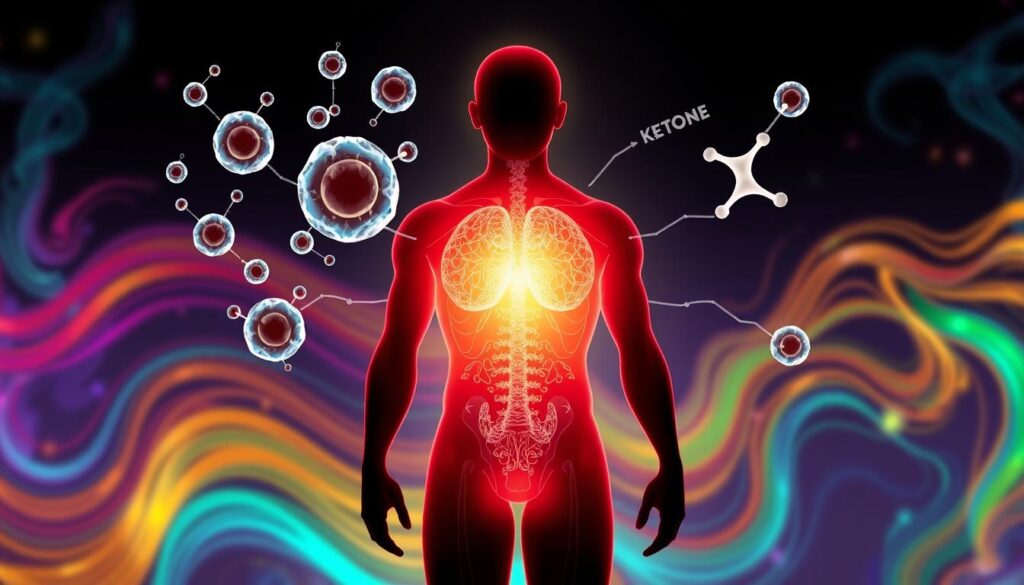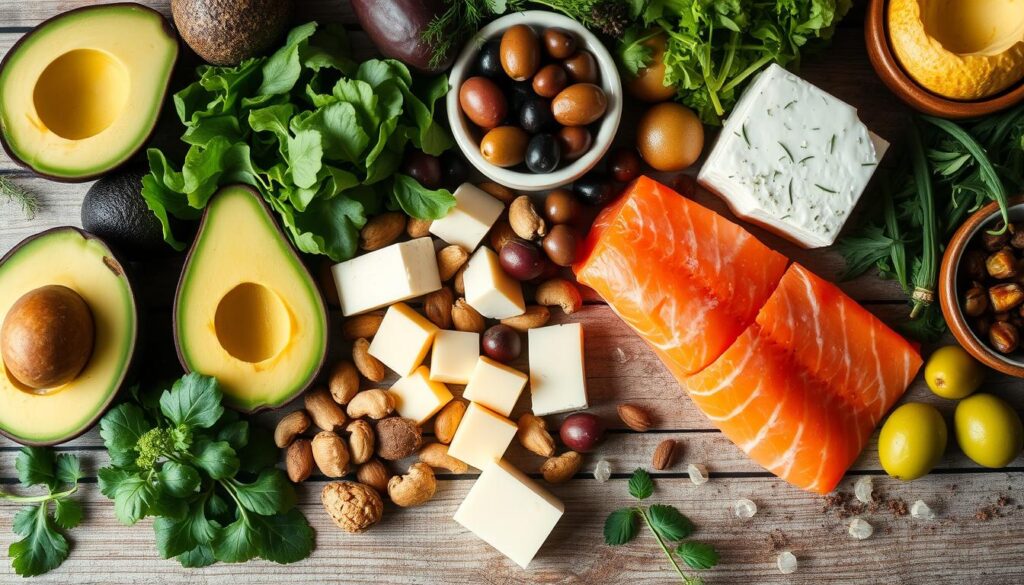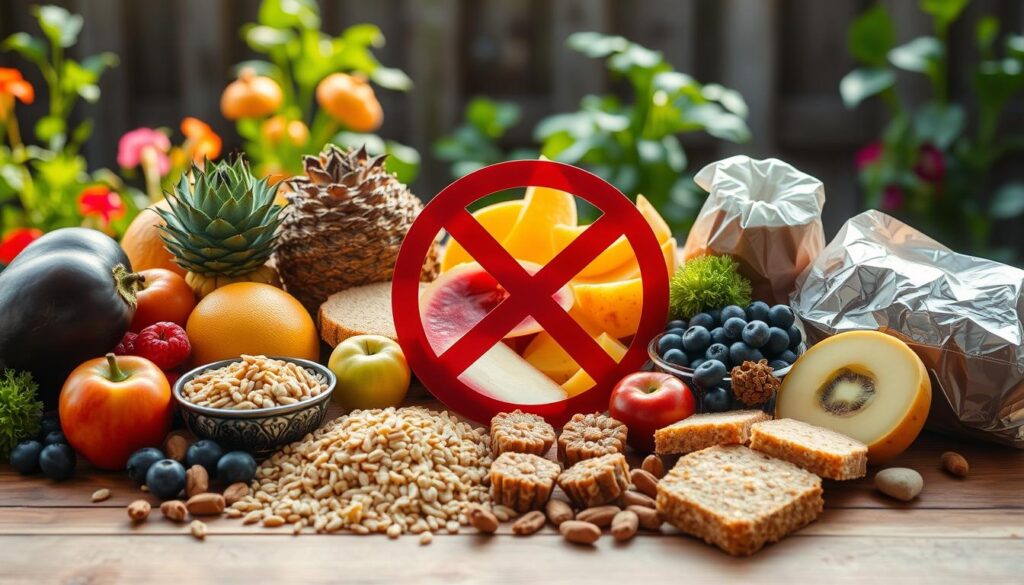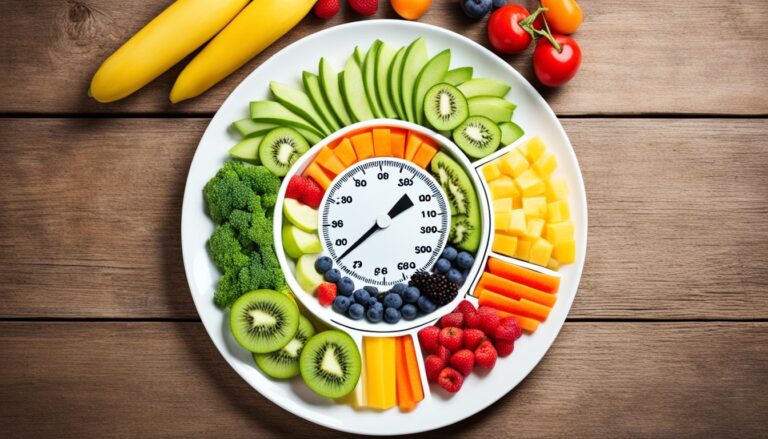Are you curious about the ketogenic diet and its benefits? This diet is low in carbs and high in fat.
It’s known for helping with weight loss and improving health. But what is it, and how does it work? Let’s explore the basics and see how it can change your body and health.
Key Takeaways
- The ketogenic diet is a high fat low carb way to eat. It puts your body into ketosis.
- It has 70% fat, 20% protein, and only 10% carbs. This can lower blood sugar and insulin levels a lot.
- The keto diet helps with weight loss and heart health. It may also help with conditions like epilepsy, Alzheimer’s, and Parkinson’s.
- Starting the keto diet can cause water loss and keto flu at first. But these effects usually go away.
- Knowing the right food ratios and what to eat and avoid is key to staying in ketosis.
Understanding the Ketogenic Diet Fundamentals
The keto diet is a unique way to manage weight and health. It’s different from other diets because it cuts down on carbs a lot. You only eat carbs for 5-10% of your daily calories.
This big change makes your body go into ketosis. In ketosis, your body uses fat for energy instead of sugar.
The Science Behind Fat Adaptation
When you start the keto diet, your body gets better at using ketones for energy. Ketones are what your body makes from fat. This process is called fat adaptation.
It takes time but can lead to many health benefits. These include better weight control and improved brain function.
Historical Development of the Diet
The ketogenic diet has a rich history. It was first used in the 1920s to help people with epilepsy. Since then, scientists have studied it for treating many health issues.
These include type 2 diabetes, Alzheimer’s disease, and some cancers.
What Makes Keto Different from Other Diets
The keto diet is special because of its high-fat, moderate-protein, and very low-carb mix. This mix is what puts your body into ketosis. It’s different from diets that focus on balanced nutrients.

The keto diet is a game-changer for those looking to optimize their health and achieve sustainable weight loss. By tapping into the power of fat adaptation, individuals can unlock a range of benefits that go far beyond just shedding pounds.
How Ketosis Transforms Your Metabolism
The ketogenic diet changes how your body works. It cuts down on carbs, to 20-50 grams a day. This puts your body in a state called ketosis.
In ketosis, your liver turns fat into ketone bodies. These can power your brain and other organs.
This change is big for your body. It stops using carbs for energy and starts using fat as the main energy provider. This is called fat adaptation.
This shift brings many benefits:
- More fat burning and weight loss
- Better insulin sensitivity, good for type 2 diabetes
- Help for conditions like epilepsy, Alzheimer’s disease, and Parkinson’s disease
But starting ketosis can be tough. Some feel the keto flu with symptoms like tiredness, headaches, and stomach issues. It’s important to manage these side effects well.
Ketosis can unlock new energy and fat burning abilities. By knowing how it works, you can use ketosis to improve your health and well-being.

The Essential Macronutrient Ratios for Keto Success
The key to a successful ketogenic diet is finding the right balance of macronutrients. You need to eat 70-80% fat intake, 10-20% protein requirements, and 5-10% carb limits. This ratio is what makes the ketogenic diet special and helps you enter ketosis.
Fat Intake Guidelines
Most of your calories should come from healthy fats. Foods like avocados, nuts, seeds, olive oil, and fatty fish are good choices. They give you energy and help your body function well. You should aim for 165 to 180 grams of fat each day, based on your calorie needs.
Protein Requirements
Protein is important, but too much can stop ketosis. Aim for 10-20% of your daily calories from protein. For a 2,000-calorie diet, that’s about 75 grams of protein per day.
Carbohydrate Limits
Carbs are the most limited on a keto diet, with a daily limit of 20-50 grams. This helps your body use fat for energy instead of carbs. Keeping carb intake low is key to staying in ketosis and getting the most from the diet.

Remember, these ratios might change based on your goals and activity level. Talking to a healthcare professional or dietitian can help find the right balance for you.
Foods to Embrace on a Ketogenic Diet
Starting a ketogenic diet means choosing the right foods carefully. Focus on keto foods, low-carb vegetables, healthy fats, and keto-friendly proteins. These foods help your body burn fat efficiently.
Meat, fatty fish, and eggs are great for protein. Grass-fed beef and wild-caught salmon are better than others because they have more omega-3s.
Leafy greens, broccoli, cauliflower, zucchini, and bell peppers are key. They’re low in carbs but full of fiber, vitamins, and minerals.
It’s important to eat healthy fats too. Avocados, nuts, seeds, and olive oil are good for you and help meet your fat needs.
Full-fat dairy like Greek yogurt and cottage cheese are okay. They mix healthy fats and keto-friendly proteins well.
| Keto-Friendly Foods | Nutritional Benefits |
|---|---|
| Grass-fed Beef | High in omega-3 fatty acids, vitamin B12, and iron |
| Wild-caught Salmon | Rich in omega-3 fatty acids, vitamin D, and selenium |
| Eggs | High in protein, vitamins, and minerals |
| Avocados | Excellent source of healthy monounsaturated fats |
| Leafy Greens | Low in carbs, high in fiber, vitamins, and minerals |

Embracing the right low-carb, high-fat foods is the key to success on a ketogenic diet.
Foods to Avoid for Maintaining Ketosis
Following a ketogenic diet means watching what you eat closely. The diet focuses on fats, moderate proteins, and low carbs. Some foods should be avoided to stay in ketosis and enjoy the diet’s benefits.
Hidden Carb Sources
Some foods might seem harmless but can have hidden carbs. Sauces, condiments, and processed foods often have sugars or starches. Always check labels and choose low-carb options when you can.
Common Food Pitfalls
- Nuts and nut-based snacks: While nuts are keto-friendly, eating too much can lead to carbs.
- Dairy products: Even low-carb dairy like cheese and yogurt can have hidden carbs. Choose high-fat, low-carb options.
- Artificial sweeteners: They might be calorie-free, but some can still cause insulin to rise, affecting ketosis.
Restaurant Challenges
Eating out on keto can be hard because many menu items are high in carbs. To stay keto while dining out, research menus, ask about ingredients, and ask for keto-friendly modifications. Choose dishes with healthy fats and low-carb veggies. Avoid breaded, fried, sugary, and high-carb items.
| Food Item | Carb Content |
|---|---|
| Slice of Bread | 11 g net carbs |
| Medium Banana | 24 g net carbs |
| Cup of Corn | 32 g net carbs |
| Medium Potato | 33 g net carbs |
| Cup of Cooked Beets | 14 g net carbs |
By avoiding hidden carbs, common pitfalls, and restaurant challenges, you can stick to the keto diet restrictions. This helps maintain ketosis for better health and weight control.

Health Benefits Beyond Weight Loss
The ketogenic diet offers more than just weight loss. It may help control blood sugar and improve heart health. Keto health benefits include better insulin sensitivity and blood sugar control for those with type 2 diabetes. It also helps with triglycerides and HDL cholesterol, important for heart health.
This diet may also protect the brain. Research shows it could help with conditions like epilepsy, Alzheimer’s, and Parkinson’s. By using ketones for energy, it may reduce symptoms and slow disease progress.
There’s also interest in using the ketogenic diet to fight cancer. Early studies suggest it might starve cancer cells, making them easier to treat. More research is needed, but the results are promising.
The diet may also help with polycystic ovary syndrome PCOS. It improves insulin sensitivity, which can help with obesity and irregular periods. This could restore hormonal balance in those with PCOS.
The ketogenic diet’s benefits go beyond weight loss. It helps with diabetes management, heart health, and neurological disorders. As research grows, we’re learning more about its health benefits.
Understanding Different Types of Ketogenic Diets
The ketogenic diet has become popular for its health benefits and weight loss. There are many variations of this diet, each suited for different needs and lifestyles. These variations help people achieve and keep a state of ketosis.
Standard Ketogenic Diet SKD
The Standard Ketogenic Diet SKD is the most studied and followed keto diet. It has a mix of 70% fat, 20% protein, and 10% carbs. This mix helps the body burn fat for energy instead of carbs.
Cyclical Ketogenic Diet CKD
The Cyclical Ketogenic Diet CKD includes days with more carbs, called carb refeeds. It alternates between strict keto days and days with more carbs. This diet is good for athletes or those who are very active, as it helps with energy and performance.
Targeted Ketogenic Diet TKD
The Targeted Ketogenic Diet TKD is like the SKD but lets you eat more carbs before workouts. It gives you quick energy for exercise while keeping you in ketosis. This diet is great for active people who want to perform well without leaving ketosis.
Every keto diet variation has its own benefits and suits different needs. It’s key to talk to a healthcare expert or a nutritionist to find the best keto diet for you.
Managing Side Effects and the Keto Flu
Starting a ketogenic diet can lead to a temporary condition called the keto flu. Symptoms include headaches, fatigue, nausea, and feeling irritable. But, with the right approach, these issues can be lessened.
The keto flu happens when your body starts using fat for energy instead of carbs. This change can cause imbalances in electrolytes, leading to dizziness, muscle cramps, and brain fog. Drinking plenty of water and replacing lost electrolytes like sodium, potassium, and magnesium can help.
Other side effects might include constipation, bad breath, and changes in cholesterol levels. Eating enough fiber, staying active, and checking your blood work can help manage these. Always talk to a doctor if you’re worried about any symptoms.
The keto flu usually doesn’t last long, from a few days to weeks. With the right steps and focus on electrolyte balance, adjusting to a fat-burning diet can be easier.
Understanding the keto flu and how to handle it can make starting a ketogenic diet smoother. Drinking enough water, keeping an eye on electrolytes, and slowly cutting carbs can help your keto journey.
Ketogenic Diet Basics A Beginner’s Guide
Starting the ketogenic diet can feel overwhelming at first. But, with some planning, you can easily switch to a keto-friendly diet. The main idea is to eat fewer carbs and more healthy fats.
When starting keto, it’s important to have the right foods ready. You’ll need meats, fish, eggs, full-fat dairy, nuts, seeds, and low-carb veggies. Stay away from foods high in carbs like grains, legumes, and most fruits. This helps keep your body in ketosis, where it burns fat for energy.
To keep track of what you eat, keto for beginners often use food journals or apps. This helps you find the right balance of carbs, proteins, and fats. Remember to drink plenty of water and replace lost electrolytes, as the keto diet can cause the keto flu at first.
Be patient when starting keto. It can take weeks for your body to get used to using ketones for energy. It’s also wise to talk to a healthcare professional, especially if you have health issues. They can help make sure the keto diet is right for you.
By following these keto tips and making small changes, you can succeed on your keto journey. You’ll get to enjoy the benefits of eating fewer carbs and more fats.
The ketogenic diet is a powerful tool for weight loss and improved health, but it requires a thoughtful approach, especially for beginners. With the right guidance and mindset, you can make the transition and unlock the full potential of this transformative diet.
Measuring and Tracking Ketosis Progress
Following a ketogenic diet means keeping an eye on your progress. There are several ways to check if you’re in ketosis. You can use blood tests, breath analysis, or urine tests. Each method gives you different insights into how your body is changing.
Blood Ketone Testing
Blood ketone testing is the most accurate way to check ketosis. It measures beta-hydroxybutyrate in your blood. This shows how well your body is burning fat. It’s the best way to track your ketone testing and ketosis monitoring for better keto progress.
Breath and Urine Testing
You can also check ketosis with breath and urine tests. Breath tests look for acetone, a ketone body, in your breath. Urine strips find acetoacetate, another ketone, in your urine. These tests aren’t as precise as blood tests but are easy to use for ketosis monitoring.
Physical Indicators
Your body also shows signs of ketosis. You might feel less hungry, have more energy, and think clearer. You might even notice a fruity smell in your breath. These signs help you see how well your body is adjusting to the diet.
Testing regularly, whether with blood, breath, or urine tests, helps you stay on track. It lets you see how your body reacts to the ketogenic diet. This way, you can make changes to improve your keto progress and reach your health goals.
Conclusion
The ketogenic diet can help with weight loss and managing health issues. But, it’s not for everyone. Some people see big benefits, like losing weight and better blood sugar control. Yet, sticking to the keto diet long-term can be tough because it’s very restrictive.
It’s key to remember that the keto diet might not work for everyone. Always talk to a healthcare professional before starting this diet. Think about your health needs, what you like to eat, and if you can stick to it for the long haul.
For lasting weight loss and better health, find a diet that fits you. The keto diet can be helpful, but it’s important to be flexible and mindful. Aim for a diet that’s balanced, varied, and full of nutrients.





